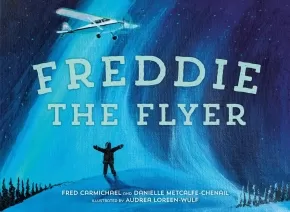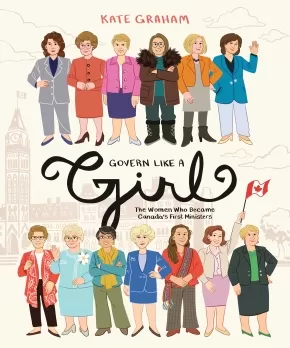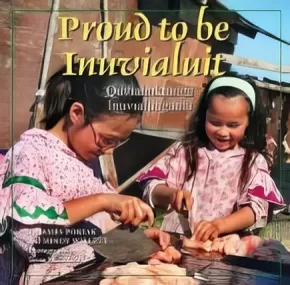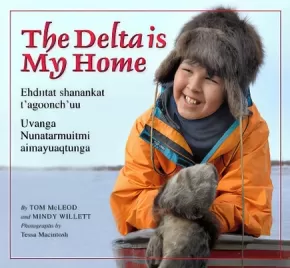
Inuvialuit (Mackenzie Inuit)
1
-
6
of
6 Results;
Sort By
Freddie the Flyer
$23.99
Artists:
Format:
Hardcover
Text Content Territories:
Indigenous Canadian; First Nations; Dene; Dinjii Zhuh (Gwich'in);
ISBN / Barcode: 9781774880807
Synopsis:
Synopsis:
A gorgeous picture book that pays homage to aviator Freddie Carmichael — the first Indigenous commercial pilot in the Arctic —with each month of the year highlighting moments from his life, the beauty of the North and the power of dreams.
When Freddie was young, he saw a plane up close for the first time when it dropped off supplies at his family’s remote bush camp. He was instantly hooked.
Freddie has flown for nearly seventy years, doing everything from supply runs to search and rescue to transporting dog teams to far-flung areas.
This book celebrates Freddie’s early dreams of flying and his later achievements. Readers move with Freddie through the year, hearing about his journey as a pilot and leader, while learning the names of the months in Gwich’in and Inuvialuktun at the same time. Art from Inuvialuit painter Audrea Loreen-Wulf perfectly captures the incredible Western Arctic as well as Freddie’s love for aviation.
Reviews
"The story of an Indigenous boy who dreamed of taking to the sky unfolds across the year in this picture-book biography that draws on Gwich’in language, the power of an unshakable passion, and, as rendered in the gorgeous painted illustrations, the beauty of nature." —Booklist
Educator Information
Recommended for ages 3 to 7.
Additional Information
32 pages | 11.31" x 8.25" | Hardcover
Govern Like a Girl: The Women Who Became Canada's First Ministers
$22.95
Format:
Paperback
Text Content Territories:
Indigenous Canadian; Inuit; Inuvialuit (Mackenzie Inuit);
ISBN / Barcode: 9781772602104
Synopsis:
Synopsis:
What does it take to govern like a girl? A fascinating look at the trailblazing women who rose to the top as first ministers in Canada.
Only twelve women have ever served as the premier of a Canadian province or territory, and only one has risen to the very top to serve as prime minister. In Govern Like a Girl, Kate Graham tells the stories of these thirteen women, from childhood to political power. Their experiences span three decades, every political stripe, and extend from coast to coast to coast. What motivated them to run for office? What did they accomplish once they were elected? And how did their style of governing differ from male politicians?
From Indigenous premiers, Eva Aariak and Nellie Cournoyea, to Premier and later Senator Catherine Callbeck of Prince Edward Island, to Québec's first female premier, Pauline Marois, these powerful women changed Canada for the better and showed the world how to govern like a girl.
Educator Information
Recommended for ages 9 to 12.
Includes a glossary and a map of Canada.
Learn about:
Premier Eva Aariak, Nunavut
Premier Catherine Callbeck, Prince Edward Island, and later, Senator
Prime Minister Kim Campbell
Premier Christy Clark, British Columbia
Premier Caroline Cochrane, Northwest Territories
Premier Nellie Cournoyea, Northwest Territories
Premier Pat Duncan, Yukon, and later, Senator
Premier Kathy Dunderdale, Newfoundland and Labrador
Premier Rita Johnston, British Columbia
Premier Pauline Marois, Quebec
Premier Rachel Notley, Alberta
Premier Alison Redford, Alberta
Premier Kathleen Wynne, Ontario
Additional Information
112 pages | 7.50" x 9.00" | 13 b&w illustrations | Paperback
Fatty Legs: A True Story (10th Anniversary Edition) (PB)
$15.95
Artists:
Format:
Paperback
Text Content Territories:
Indigenous Canadian; Inuit; Inuvialuit (Mackenzie Inuit);
ISBN / Barcode: 9781773213507
Synopsis:
Synopsis:
The beloved story of an Inuvialuit girl standing up to the bullies of residential school, updated for a new generation of readers.
Margaret Olemaun Pokiak-Fenton’s powerful story of residential school in the far North has been reissued to commemorate the memoir’s 10th anniversary with updates to the text, reflections on the book’s impact, and a bonus chapter from the acclaimed follow-up, A Stranger at Home. New content includes a foreword from Dr. Debbie Reese, noted Indigenous scholar and founder of American Indians in Children’s Literature, while Christy Jordan-Fenton, mother of Margaret’s grandchildren and a key player in helping Margaret share her stories, discusses the impact of the book in a new preface.
With important updates since it first hit the shelves a decade ago, this new edition of Fatty Legs will continue to resonate with readers young and old.
Reviews
"I highly recommend this book for the discussion it would stir with students...Makes the harrowing residential school stories accessible to youth." — Resource Links
"Presents a unique and enlightening glimpse into the residential school experience and, most importantly, one little girl's triumph over her oppressors." — Quill & Quire
"Fatty Legs is a memoir written to introduce children to the reality of the residential school system and the focus on assimilating Indigenous peoples. The story documents the journey of a young girl who wanted to go to school to learn to read and her realization that school wasn’t what she imagined it to be." — The Dalai Lama Center
Educator Information
Themes: biography; Inuit; Indigenous peoples; Indigenous; arctic; school; self-esteem; abuse; community; prejudice; Canadian content; courage/bravery; right vs. wrong; role reversal; secrets; society; history; bullying; memoir; character education.
This resource is also available in French: Les bas du pensionnat
This resource is also available in its original format: Fatty Legs: A True Story
Additional Information
| 156 pages | 6.50" x 9.00" |
Authenticity Note
This illustrator of this book is not Indigenous; therefore, her artwork is not considered to be Authentic Indigenous Artwork according to Strong Nations Authenticity Guidelines. The archival photos from Margaret Pokiak-Fenton's personal collection, however, are considered to be authentic, which is why the book is labelled as containing Authentic Indigenous Artwork. It is up to readers to determine whether or not the images in this work are authentic for their purposes.
A Stranger at Home: A True Story
$12.95
Editors:
Format:
Paperback
Text Content Territories:
Indigenous Canadian; Inuit; Inuvialuit (Mackenzie Inuit);
ISBN / Barcode: 9781554513611
Synopsis:
Synopsis:
The powerful memoir of an Inuvialuit girl searching for her true self when she returns from residential school.
Traveling to be reunited with her family in the Arctic, 10-year-old Margaret Pokiak can hardly contain her excitement. It's been two years since her parents delivered her to the school run by the dark-cloaked nuns and brothers.
Coming ashore, Margaret spots her family, but her mother barely recognizes her, screaming, "Not my girl." Margaret realizes she is now marked as an outsider.
And Margaret is an outsider: she has forgotten the language and stories of her people, and she can't even stomach the food her mother prepares.
However, Margaret gradually relearns her language and her family's way of living. Along the way, she discovers how important it is to remain true to the ways of her people -- and to herself.
Highlighted by archival photos and striking artwork, this first-person account of a young girl's struggle to find her place will inspire young readers to ask what it means to belong.
Sequel to Fatty Legs.
Reviews
"This memoir, detailing a woeful piece of Canadian history and demonstrating Margaret's strength of character, compassion, courage and her willingness to sacrifice herself for her family's sake, gives the reader a lot to ponder. Highly recommended." — Shelbey Krahn, Canadian Materials, February 2012
"A Stranger at Home will speak to anyone who has experienced displacement or assimilation into a new culture. This fabulous story enhances the Grades 6 to 8 social studies curriculum." — Professionally Speaking (Ontario College of Teache, April 2012
"While it may not have the same drama and tension of the first memoir, this tale provides a compelling and moving story of a girl searching for the strength to find her place in the world." — Jody Kopple, School Library Journal, December 2011
"Without being graphic or overwhelming, the Fentons recreate a tragic moment in Canadian history through the innocent reflections of a child...a must for any classroom library." — Canadian Teacher Magazine, May 2012
"This tale provides a compelling and moving story of a girl searching for the strength to find her place in the world. The writing is unpretentious and accessible and readers who enjoyed the first book will find this an interesting follow-up. Vivid paintings are a beautiful accompaniment to the storytelling. Photographs from Pokiak Fenton's own collection add important points of reference for readers looking to visualize the characters and the unique setting of the Arctic Circle. A welcome addition to biography collections." — Jody Kopple, School Library Journal, December 2011
Educator Information
Recommended Ages: 9-13.
Guided Reading Level: Fountas and Pinnell U
Themes: biography; Inuit; Indigenous peoples; arctic; residential schools; identity; community; Canadian content; family; society; history; memoir.
This resource is also available in French: Étrangère chez moi
Additional Information
128 pages | 6.25" x 9.00"
Proud to Be Inuvialuit: Quviahuktunga Inuvialuugama
$19.95
Artists:
Format:
Hardcover
Text Content Territories:
Indigenous Canadian; Inuit; Inuvialuit (Mackenzie Inuit);
ISBN / Barcode: 9781897252598
Synopsis:
Synopsis:
James Pokiak is proud to be Inuvialuit, which means "real people."
The Inuvialuit are the most westerly Canadian Inuit. James lives in the hamlet of Tuktoyuktuk, NWT, which is above the Arctic Circle on the shore of the Arctic Ocean. The community is often just called Tuk to save time. Even though he lives in town now, James grew up on the land, learning the traditional values and survival skills of his people.
In this book, the fifth in the The Land is Our Storybook series, James and his daughter, Rebecca, go on a trip to harvest beluga whale. Harvesting and preparing beluga meat together as a family is an integral part of what it means to be Inuvialuit. Join James and Rebecca and learn about how the beluga whale is interlinked with Inuvialuit culture and history.
Educator & Series Information
Recommended Ages: 8-12
This is the fifth book in the The Land Is Our Storybook Series, a first-ever series of books for children about the diverse lands and cultures of Canada's Northwest Territories.
Additional Information
32 pages | 8.33" x 8.25"
The Delta Is My Home
$16.95
Format:
Hardcover
Text Content Territories:
Indigenous Canadian; Inuit; Inuvialuit (Mackenzie Inuit); First Nations; Dene; Dinjii Zhuh (Gwich'in);
ISBN / Barcode: 9781897252321
Synopsis:
Synopsis:
Tom McLeod is an eleven-year-old boy from Aklavik who is a gifted storyteller heard frequently on CBC Radio North. He is of mixed cultural heritage-Gwich'in and Inuvialuit.
Tom tells us why his home in the Mackenzie Delta is a special place and why he loves to live on the land. He describes how his town floods in the spring and why he loves "ratting" (trapping muskrats) and hunting "black ducks" (white-winged and surf scoters) in the Delta. Readers will learn why these ducks are decreasing in number and how and why they are important to Tom and his people.
Tom says, "Northerners have always hunted animals for survival. We are careful about how we use the land. To be good hunters we need to pay attention to what is happening on the land around us-that's why it's important for us to be out there. We are the first to know if the land and animals are changing."
Reviews
"The Delta is My Home, is presented in way children will take pleasure in reading. They will be enthralled with the photographs and in the end they will learn a great deal about the culture, family and life of Tom McLeod and the Gwich'in people." — ForeWord Magazine
"...a valuable introduction to an endangered culture." — Booklist
"Tom's bouncingly fun personality beams from every page. . . This is an exciting series for helping children, especially those outside the Northwest Territories, appreciate the day-to-day world of their peers." — Canadian Children's Book News
"[The Delta Is My Home] feature[s] a satisfying mix of old and new - traditional and contemporary - in the photographs and text. . . What both photos and text do very well is establish the strong connection between the people in the books and the land upon which they live. . . A book that children [will] choose to read both for pleasure and for information. — CM Magazine
Educator & Series Information
This book is part of the "The Land Is Our Storybook" series, which considers the diverse lands and cultures of Canada's Northwest Territories. Told in a uniquely diverse range of northern voices, with a child-centred approach, books in the series highlight each official Aboriginal language group in the NWT, revealing a richly textured picture of life in the North-on the trapline, around the campfire, in communities, at school, and within the outdoor school that is the land itself. The series celebrates the seasons, ages, genders, traditional activities, and communities of the NWT.
The stories are illustrated by the striking images of acclaimed northern photographer, Tessa Macintosh and depict the similarities in lifestyle between children of the North and South, as well as the marked cultural differences, and highlight the special relationship these First Nations people have with the land and how they are adapting to rapid change while remaining connected to the land. Images of the landscape and animals within it, of trapping, hunting, fishing, and bannock baking sit alongside pictures of children at school, swimming at recreation centres, and reading in libraries. Here is modern northern culture painted beautifully: a complex mix of the new and the old.
These wonderful books, written with a variety of provincial and territorial curricula in mind, are specially designed for the classroom and include special features such as glossaries relating details on animals biology and cultural definitions, regional and language maps. The text of the stories also have sidebars such as Our Stories, which contain the stories of the people and language group featured, and Our Words, which highlight words in the featured language that are important to the story.
Recommended Grade Level: 2-7
This resource is also available in French: Le Delta, c'est mon chez moi
Additional Information
32 pages | 8.00" x 8.00" | colour photographs, illustrations, map
Sort By












